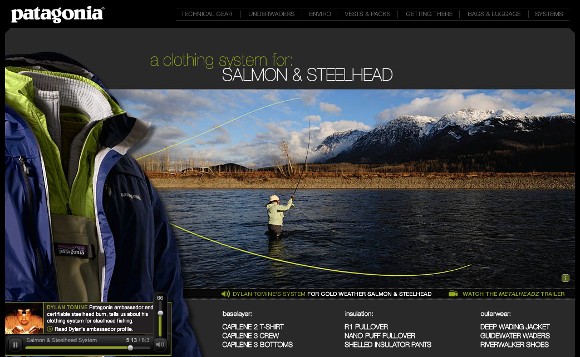That a major fly fishing manufacturer
produced an online catalog isn't wholly a shock, though few companies in the comparatively tiny fly fishing market can offer up the kind of presence needed to get that
catalog featured on an L.A. Times site.
Patagonia seems to be that company.

From the
LA Times web site:
Outdoor and fishing apparel manufacturer Patagonia is doing away with its traditional fly-fishing catalog, instead switching to an online "e-Catalog" only.
"The fishing market is the right place to launch an e-Catalog," said Patagonia angling Chief Executive Casey Sheahan. "Anglers have turned to the Internet to review water conditions, hatches, plan trips and more, making them the perfect customer for an online, interactive e-Catalog that feels more like a magazine or multimedia site."
The Web-based, interactive catalog will allow users to view videos and access in-depth product information, as well as provide avenues to purchase items quickly and easily.
"Our hope is that anglers are psyched to get product information this way, so moving forward we can try to avoid sending catalogs to individual mailboxes."
Whether the time is truly right remains to be seen; it was only a couple years ago that a small manufacturer I know - someone who sells into the outdoor and food service markets - also went to a digital catalog.
The only real pushback? It came from the fly fishing industry, many of whom didn't seem to know what a digital catalog was, or why an industry largely based on clean water would find it desirable.
The times are changing, though I'd suggest
fly fishing's anglers are ahead of the industry when it comes to the Internet.
I say, Is That a Direct Sales Model?As noted by an eagle-eyed Undergrounder, clicking on a product in Patagonia's online catalog (I've been eying the
Pack Vest, so let's click that) sends you straight to the Patagonia Web site, where you'll find plenty of product information - and are offered the chance to
conveniently buy the item immediately.
It's a subtle reminder that the Internet is truly enabling a direct sales model, and while Patagonia has always been something of a catalog company, you know that other manufacturers - largely prevented from direct sales by their commitment to a dealer network - are eying that direct channel (and its "forget about wholesale pricing" margins) somewhat covetously.
Mike Michalak - owner of The Fly Shop in Redding (perhaps the biggest online && offline retailer in terms of revenue) alluded to this in the
March issue of Angling Trade, where he wrote an opinion piece suggesting dealers were about to witness an industry turning to a direct sales model at the expense of fly shops.
I think it's a given that will come to pass on some level, especially given homogeneity of so many fly shops.
In simple terms, the fly fishing market isn't all that big; fewer manufacturers means fewer choices - and fly shops which already carry pretty much the same gear will be forced to differentiate themselves in other ways.
Those that can't will disappear.
Direct sales? Manufacturers are eying the channel, but many find their hands are tied.
Of course, Patagonia's already tapped into direct sales, though if you want to see an aggressive operation, you have to look no further than the old-skool
Orvis site.
Sure, it's cluttered, but beneath it lurks a very advanced email program, plenty of new-school product marketing (like customer product reviews - text
and video), a host of other features guaranteed to make a modern marketer smile, and yes - even a burgeoning social media effort.
Meanwhile, competing manufacturers like Scott, Winston && Sage seem content to roll out "new" web sites that look, operate - and fail to engage - exactly like their old Web sites.
The Internet isn't about to disappear fly fishing's fly shops, but those shops - and manufacturers - who are slow to recognize its real impacts are doomed to stand on the sidelines while others eat their market share like a stolen lunch.
Patagonia seems to be justifying its new catalog on the basis of environmental impacts. Yet that ignores the very real ability to deliver rich content (video, audio, animation, etc) that can't happen via print.
And yes, it gives you the ability to direct interested buyers exactly where you want - including to the "buy this" page on your own Web site.